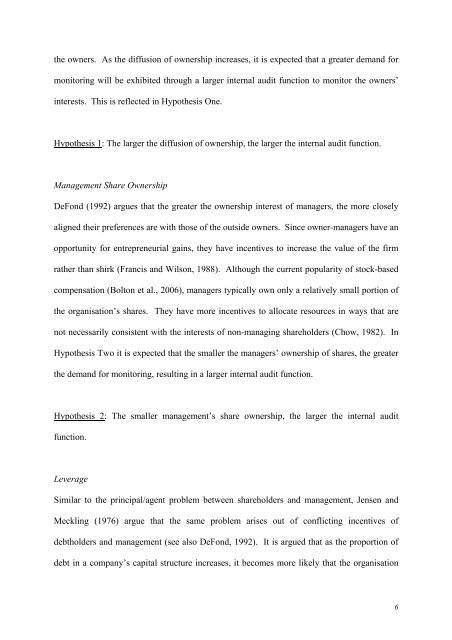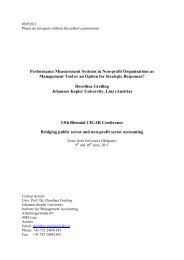WORKING PAPER - Faculteit Economie en Bedrijfskunde
WORKING PAPER - Faculteit Economie en Bedrijfskunde
WORKING PAPER - Faculteit Economie en Bedrijfskunde
Create successful ePaper yourself
Turn your PDF publications into a flip-book with our unique Google optimized e-Paper software.
the owners. As the diffusion of ownership increases, it is expected that a greater demand for<br />
monitoring will be exhibited through a larger internal audit function to monitor the owners’<br />
interests. This is reflected in Hypothesis One.<br />
Hypothesis 1: The larger the diffusion of ownership, the larger the internal audit function.<br />
Managem<strong>en</strong>t Share Ownership<br />
DeFond (1992) argues that the greater the ownership interest of managers, the more closely<br />
aligned their prefer<strong>en</strong>ces are with those of the outside owners. Since owner-managers have an<br />
opportunity for <strong>en</strong>trepr<strong>en</strong>eurial gains, they have inc<strong>en</strong>tives to increase the value of the firm<br />
rather than shirk (Francis and Wilson, 1988). Although the curr<strong>en</strong>t popularity of stock-based<br />
comp<strong>en</strong>sation (Bolton et al., 2006), managers typically own only a relatively small portion of<br />
the organisation’s shares. They have more inc<strong>en</strong>tives to allocate resources in ways that are<br />
not necessarily consist<strong>en</strong>t with the interests of non-managing shareholders (Chow, 1982). In<br />
Hypothesis Two it is expected that the smaller the managers’ ownership of shares, the greater<br />
the demand for monitoring, resulting in a larger internal audit function.<br />
Hypothesis 2: The smaller managem<strong>en</strong>t’s share ownership, the larger the internal audit<br />
function.<br />
Leverage<br />
Similar to the principal/ag<strong>en</strong>t problem betwe<strong>en</strong> shareholders and managem<strong>en</strong>t, J<strong>en</strong>s<strong>en</strong> and<br />
Meckling (1976) argue that the same problem arises out of conflicting inc<strong>en</strong>tives of<br />
debtholders and managem<strong>en</strong>t (see also DeFond, 1992). It is argued that as the proportion of<br />
debt in a company’s capital structure increases, it becomes more likely that the organisation<br />
6
















